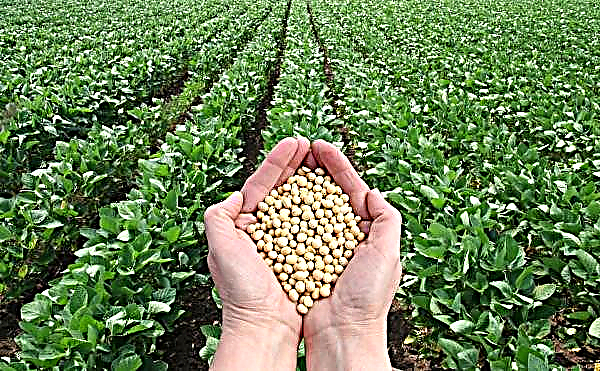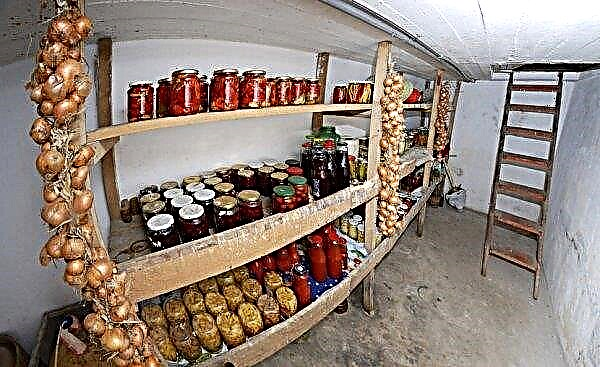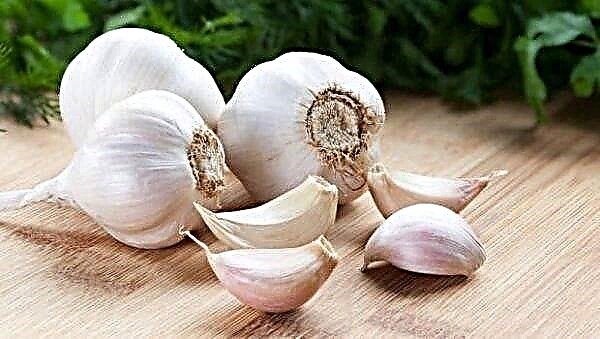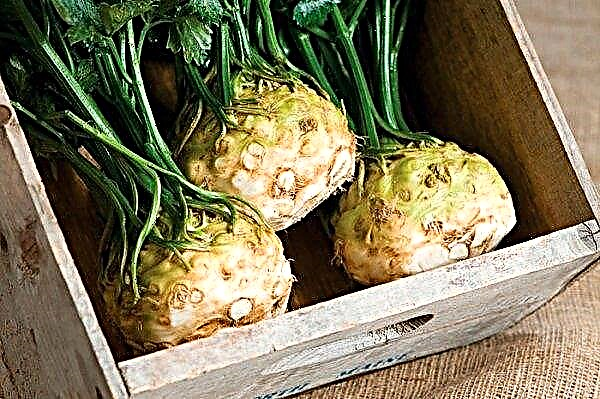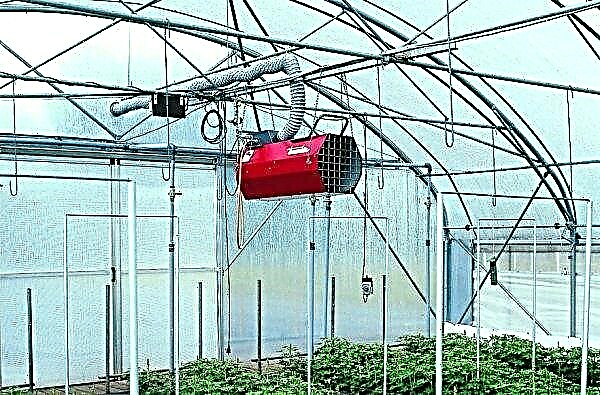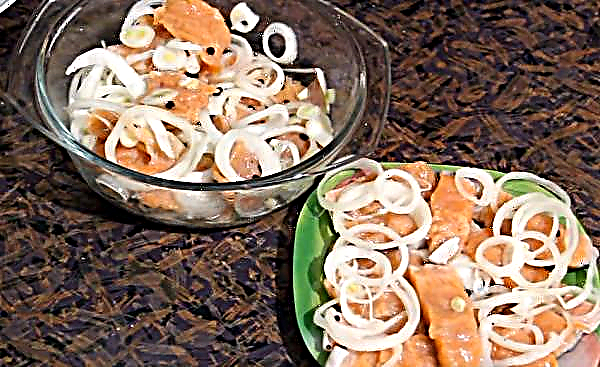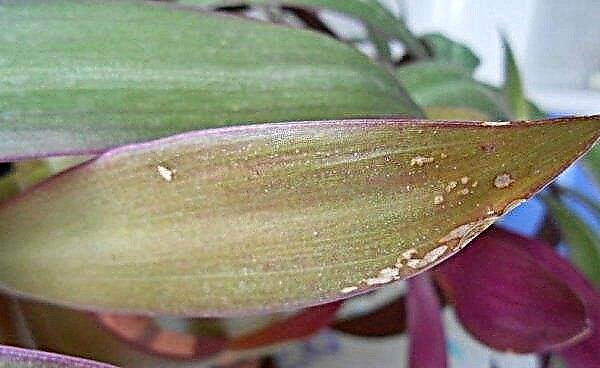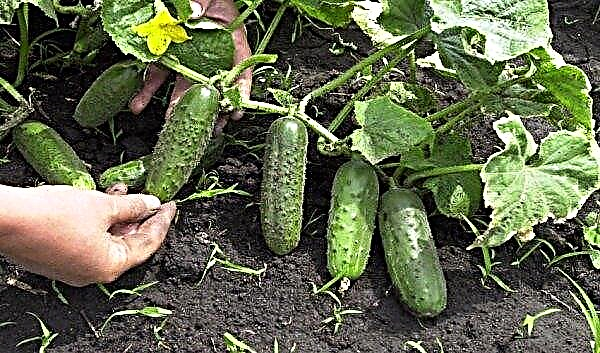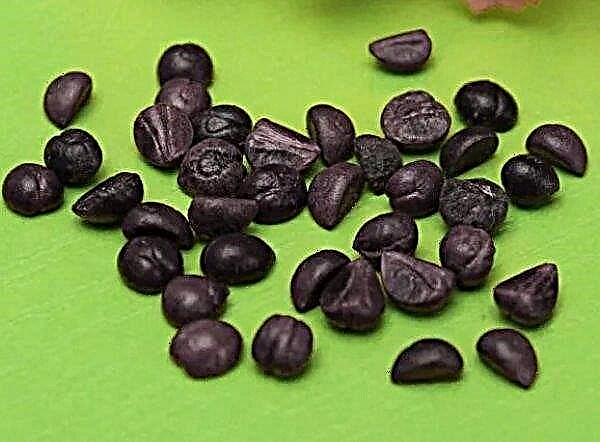Cucumber makes high demands on growing conditions. This is especially true of nutrition, therefore, providing cucumber plantings with the necessary nutrients is a guarantee of a stable yield. Read more about dressing cucumbers with folk remedies.
Did you know? The fruits of cucumbers of the Chinese Miracle variety can reach a length of 100-120 cm. When grown on trellises, the fruits become long and even, and without garter — curl up into fancy rings and spirals.
What do cucumbers love
The need for cucumber dressing is associated with the structure of the roots of this plant (extensive, but shallow) and rapid growth of mass. At the beginning of cultivation, when intensive construction of leaves and stems occurs, the culture absorbs mainly nitrogen. However, in the phase of ovary formation, mass gain and maturation, he requires potash and phosphorus fertilizers.The soil for growing this plant should be slightly acidic or neutral - pH 6.0–7.2.  Cucumbers grow well on cattle manure - it is applied in an amount of 30–35 kg per hundred square meters of land. Also, instead of manure under the culture of cucumber, you can make compost in the amount of 40-60 kg per hundred square meters (in spring). All introduced organic matter is mixed with soil, plowing or cultivating it to a depth of 8-10 cm. Organic fertilizers are applied before plowing or after harvesting. It is also possible to grow the described vegetables on siderata sown on a cucumber bed in the fall.
Cucumbers grow well on cattle manure - it is applied in an amount of 30–35 kg per hundred square meters of land. Also, instead of manure under the culture of cucumber, you can make compost in the amount of 40-60 kg per hundred square meters (in spring). All introduced organic matter is mixed with soil, plowing or cultivating it to a depth of 8-10 cm. Organic fertilizers are applied before plowing or after harvesting. It is also possible to grow the described vegetables on siderata sown on a cucumber bed in the fall.
What substances do cucumbers need
Cucumber requires intensive phosphorus fertilizer (preferably in the form of triple superphosphate), and the lack or inaccessibility of the element due to too acidic soil inhibits the formation and growth of the fruit, while not manifesting itself as obvious symptoms on the leaves and other parts of the plant.
As a source of potassium for cucumbers, only the sulfate form of this ingredient can be used. (due to the high sensitivity of the cucumber to chlorides). A slightly lower dose can be used if a high dose of manure was previously administered. An insufficient supply of this component causes fetal deformation, bending and narrowing, especially on the stem. Old leaves of the cucumber turn dark green, and yellow discoloration and dying tissue are visible at the ends of the leaf plates. In addition, a lack of potassium leads to a decrease in the suitability of cucumbers for use in pickling and marinades due to the small amount of sugar in the fruits.
Video: food for cucumbers
The main value for cucumber plantings is nitrogen, guaranteeing a good harvest. However, this element should be used very sparingly, because its excess leads to a decrease in the quality of the fruit, and the drawback is to limit the development of cucumber bushes.
Cucumbers need magnesium and boron. Sometimes you can observe a shortage of boron during planting, especially on beds without manure or when any species of cabbage was grown as a precursor crop. Cucumbers also respond favorably to foliar application, especially under stress (a sharp decrease or increase in air temperature). For this purpose, you can spray the cucumber plantings with fertilizers “Florovit” or “Miedzian” - in addition they protect plants from diseases, for example, from cucumber mosaic. With the leaf form of nutrition, the top dressing is immediately absorbed and delivered directly to the tissues.
When it is necessary to feed cucumber bushes
Culture requires nutrition in the most important periods of its development: shortly after planting, as well as in the phase of flowering and fruit formation.
Nitrogen supplements should be about 0.100 g per hundred parts in divided doses. Half of this amount, for example, in the form of ammonium nitrate, should be applied to the soil 10-14 days before sowing seeds or planting seedlings, thoroughly mixing fertilizers with the soil. The remaining amount should be divided into 2-3 doses and used as top dressing during the growing season of cucumbers.
Important! Nitrogen dressing is not recommended for cucumbers after the start of mass fruiting, since too late use of this element affects the quality of the crop: the fruits become unsuitable for processing.
The first nitrogen fertilizing should be done at the moment when the plants have 3-4 adult leaves, and the last - when the plants begin to bloom. Doses of nitrogen can be increased to 0.150 g per hundred square meters if cucumbers are grown in the second or third year after introducing manure into the garden.
However, in itself, organic fertilizer does not fully satisfy the nutrient needs of a cucumber, therefore, based on a chemical analysis of the soil, it is supplemented with mineral fertilizers, which are initially applied to the bed no later than 2-3 weeks before planting or planting. Approximate doses of fertilizers are: 0.80–0.100 g of phosphorus and 0.20–0.25 g of potash per one hundredth, which are applied on top of the beds before soil treatment in spring. During digging, mineral fertilizers should be well mixed with the soil.
After landing in open ground
Cucumber seedlings on the bed are fed 10-14 days after planting. If there is a need for feeding young cucumbers grown by direct sowing in the soil, the plants should have at least two real, well-developed leaves.
Top dressing is carried out with liquid solutions under the root. Add 10 g of ammonium nitrate, 15 g of superphosphate and potassium sulfate, and 1 l of liquid mullein solution (5 kg of cow manure 10 l of water) to a bucket of water.
During flowering and ovary formation
When the cucumber plantations bloom, the time comes for a second feeding. Usually between them takes about 14 days. You can purchase special fertilizer for flowering cucumbers, which contain boron, potassium, manganese and phosphorus. The introduction of trace elements is favorable for the growth and rapid development of cucumber bushes. For every 10 liters of water, 0.5 g of boric acid and 0.3 g of manganese sulfate are added to mineral fertilizers.
Plantings of cucumbers are also sprayed on the leaves with a mixture of water and boric acid (0.5 teaspoon per 10 liters of water). Processing is carried out twice during the fruiting season, the interval between procedures is 14 days.
During fruiting
When the fruits of the cucumber begin to form and gain mass, they need to be fed with potassium, magnesium, as well as a small amount of nitrogen. During the appearance of the first cucumbers, the plants are fed with a solution consisting of 10 l of water, 30 g of potassium sulfate and 1 tbsp. tablespoons of nitrophoska. In August, to extend the flowering and fruiting period, you can add an aqueous nutrient solution (10 l of water, 50 g of urea and wood ash) to the root zone.
Approximately in the middle of fruiting, one more top dressing is performed: during this procedure, the gardener chooses the top dressing solutions based on the state of planting. In case of poor ovary formation, a concentrated urea solution (1 liter per 10 liter of water) is used. If the plant bears fruit normally, cucumbers form correctly, have the desired density and taste, planting is fed with an ash solution or liquid fermented organics based on herbal raw materials or bird droppings.
Did you know? If you place the intact gherkins in a sterilized dry jar, put a small lighted candle there, and then roll the jar with a tin lid, then the fruits can be kept fresh for a long time. Some vegetable growers explain this phenomenon by the fact that oxygen is burned out in the bank and the process of decay cannot begin.
Top dressing for cucumbers in the open ground with folk remedies
Cucumber plantings can be fed not only with mineral substances, but also with natural fertilizers.such as wood ash, onion husks, yeast, dung, humus, fermented green manure. All these substances have a positive effect on the growth of the root system, the aerial parts of plants and on the formation of fruits. Here are 5 working recipes for biologically pure and very effective top dressing.
Ash
As a result of using a wood stove, in addition to the heat in the house, people get a by-product in the form of wood ash - it is an excellent fertilizer for cucumbers. Wood ash contains many mineralssuch as phosphorus, calcium, magnesium, silicon and a number of trace elements. It does not contain nitrogen, which is released into the atmosphere during the combustion of wood. Ash from coniferous trees contains less useful mineral components than ash obtained from deciduous trees.
Wood ash has a fragmented structure, so plants have no problems getting minerals from this substance. Ash fertilizer works slowly and, unlike other mineral fertilizers, has a fairly balanced composition. The ash reaction ranges from 11 to 13 pH, so it perfectly dehydrates the soil. Due to its natural composition, wood ash can be used in the ecological cultivation of vegetable crops.
Important! Only wood ash obtained by burning unpainted wood is useful. Coal or wood ash with the addition of cardboard, printing paper, fabrics and plastics is not suitable for fertilizing plants.
Dry ash can be poured into the root zone of plants directly on top of the soil or pollinated with leaves. In this case, about 100 g of ash is scattered on each m² of cucumber beds. You can also make a solution of 10 liters of water and 250 ml of wood ash. The solution is prepared immediately before the start of root dressing of cucumbers. 400-500 ml of nutrient fluid are poured under the root of each bush.
Manure, bird droppings, green manure
Cucumbers are very fond of organics, so experienced gardeners use pet manure, fermented green manure or liquid feeding on bird droppings to top them.
Making manure for cucumbers during the growing season:
- Parallel to a number of cucumbers, but observing a distance of 20–25 cm from the stems of the plants, a shallow trench is laid (depth and width up to 20 cm). The length of the recess is equal to the length of the cucumber row. To dig a longitudinal recess, you can use a conventional bayonet shovel or garden chopper.
- Manure is laid in the finished trench. Organics are abundantly watered and covered with soil so that the surface of the feeding trench is even with the general surface of the bed.
 Such top dressing is carried out in the second half of the growing season of the crop, when the plants are weakened by prolonged fruiting. Top dressing will help the bushes cheer up, and extend the picking season of cucumbers.
Such top dressing is carried out in the second half of the growing season of the crop, when the plants are weakened by prolonged fruiting. Top dressing will help the bushes cheer up, and extend the picking season of cucumbers.To prepare fermented top dressings based on bird droppings or grass, the gardener will need some time. Such top dressings are very concentrated, therefore, they need to be diluted with water before intended use. The main plus of liquid concentrated top dressing is that for a regular summer cottage plot of 5 acres of concentrate, prepared in a 200 liter barrel, enough for the entire summer season. Also, liquid top dressing is quite simple to apply to the culture, for example, combining with watering.
Preparation of liquid concentrated top dressing:
- A large empty tank, for example, a 200 liter plastic or iron barrel, is installed in a sunny place. The place should be secluded and protected from the wind.
- Capacity up to half the volume is filled with bird droppings or fresh nettles. Instead of nettles, you can use other fresh herbs: dandelions, knotweed, timothy, wheat grass. The main thing when filling the barrel with green raw materials is to make it as dense as possible. To put as much grass as possible into the container, it is cut into pieces of 15-30 cm.
- On top of the organic substances, water is poured into the barrel so that about 20 cm remains from the edge of the container. This gap is necessary so that during fermentation the liquid does not overflow over the edge of the barrel.

- The contents of the container are mixed with a strong long stick, after which they close the barrel with a lid. The lid is needed to prevent nitrogen loss during fermentation.
- An organic filled and closed barrel is left for 7-10 days for fermentation. Every day, the gardener will need to mix the contents of the container. Concentrated top dressing is considered finished when bubbles no longer appear on the surface of the liquid.
- Before starting work on feeding cucumbers, it is necessary to dilute the concentrate with water, using 500 ml of concentrated feeding for each bucket of clean water.
Yeast
For several decades, yeast top dressing of cucumbers has been popular among gardeners. It is carried out both on the leaf and under the root of the plants. Fresh baker's yeast contains a large number of active yeast bacteria, which, entering the plant cells, begin to work as a powerful growth stimulator.
How to cook with yeast:Important! For the manufacture of yeast dressing, only fresh (live) yeast is used: dry (granular or powder) are not suitable.
- A concentrated solution is prepared by mixing 3 liters of warm water, 100 g of fresh yeast and 5–7 tbsp. tablespoons of sugar. The solution is set in a warm place for about 3 days to insist and the fermentation process.
- Before feeding, the fermented concentrated solution is diluted in water. About 1/4 liter of concentrate is added to each bucket of liquid, mixed well and used for top dressing.

For root dressing, at least 0.5 l of liquid yeast fertilizer is poured under each plant.If the gardener decided to carry out leaf dressing, the liquid fertilizer diluted in the same proportion is poured into the pump sprayer and the cucumber plantings are treated by spraying. To carry out the procedure, choose morning time and a day without precipitation. Both root and foliar top dressing with yeast solution is carried out no more than 3 times for the entire season of the growing season of cucumbers.
Onion peel
Onion peel contains substances that can not only stimulate the growth of cucumbers, but also protect it from leaf-sucking pests, such as red spider mites and aphids.
To prepare a solution for feeding:
- Peel off 10 large onions - about 2 handfuls are obtained.
- Pour dry husk with freshly boiled water (1.5 l), set the mixture on fire and bring to a boil.
- After the onion husk solution boils, the fire is reduced to a minimum heat, the mixture is boiled for 7-10 minutes.
- The finished mixture is turned off and left to insist under the lid until it cools completely, after which it is diluted with clean water, bringing the volume of the working fluid to 6 liters.

A broth of onion husks is poured into a garden sprayer and cucumber plants are processed on it with a leaf.
Technology of top dressing folk remedies
Gardeners carry out foliar top dressing of a cucumber directly on the leaf and only in the morning. It is important that before the evening, the moisture on the leaves dry out well - otherwise the drops can serve as a breeding ground for the development of pathogenic fungal spores.
All root dressings are carried out directly in the root zone: liquid solutions are poured under the root of the plants, and dry fertilizers are laid in the recesses located near the roots of the cucumber. Liquid top dressing on organics must be insisted in order for the nutrient solution to acquire more beneficial properties.
Signs of nutritional deficiencies
Lack of nutrients weakens and delays the development of plants, they manifest symptoms of deficiency of beneficial elements.Listed below are the main signs of malnutrition in cucumbers and the measures that need to be taken to correct this situation.
Lack of nitrogen
Cucumbers need nitrogen in the early stages of growth. With its lack of bush growth is delayed, and older leaves become yellow-green. If nutrient deficiency continues, the same symptoms will appear throughout the plant. With critical nitrogen deficiency, the size of the leaves on the plant decreases, and a purple color appears on the veins of the leaves, contrasting with the pale green leaf. At the same time, flower buds turn yellow and fall. Due to a deficiency of this element, chlorosis occurs on cucumber bushes. The situation is corrected by introducing nitrogen, preferably in the form of nitrates, under the root or on a leaf culture.
Conditions predisposing to nitrogen deficiency:
- lack of nitrogen fertilizers;
- low levels of organic matter;
- high level of poorly decomposing organic matter in the soil;
- molybdenum deficiency;
- soil compaction;
- intensive soil leaching;
- prolonged drought.
Potassium deficiency
This is the nutrient most required by plants. A lack of potassium slows the growth of cucumber: the width of the new leaf blades narrows, and on the old leaves yellowing from the edges to the center appears, gradually becoming brown and drying out. Sometimes on the leaves there is the appearance of bright orange areas.
Inadequate fruit density is also often associated with a lack of potassium.. The situation can be corrected by applying fertilizers in the form of potassium chloride or potassium sulfate and combine top dressing with the next basal irrigation.
The availability of potassium for cucumbers depends on:
- the content of this element in the soil;
- leaching rates;
- excessive liming;
- the presence of high levels of calcium, magnesium and ammonia in the soil.
Phosphorus starvation
Phosphorus deficiency is often observed on poorly fertilized soils and in soils with a high leaching rate of this nutrient. The growth rate of cucumber plantings decreases, starting from the early stages of development. Older leaves turn purple due to the accumulation of anthocyanin pigment.
At later stages of development, purplish-brown areas appear on the leaves, which after a while turn into necrotic spots. Such leaves fall prematurely, and the onset of fruiting on the plant is significantly delayed. It is most reasonable to prevent a deficiency of the element on the cucumber beds and to introduce phosphate fertilizers for prevention, immediately before planting.
The absorption of phosphorus by cucumber is mainly affected by:
- the concentration of phosphorus in the soil solution;
- soil acidity or alkalinity;
- the prevailing type of soil and the amount of clay in it;
- moisture content and soil compaction;
- fertilizer application;
- low temperatures at the germination stage.
Did you know? Using cucumber pulp, you can saturate the skin with moisture, as well as give it whiteness and softness. For this, women apply slices of cucumber on their faces as a cosmetic mask.
Signs of micronutrient deficiency
Due to a lack of nutrition in cucumber bushes, various disorders of growth and development occur. Often the symptoms of a deficiency of one trace element are very similar to the symptoms of a deficiency of another.
- Plants respond to a lack of trace elements:
- the appearance of spots on the leaves;
- drying of the edges of the leaves;
- discoloration of the sheet plate;
- necrosis of leaves and stems;
- a stop in development;
- the appearance of ugly and deformed fruits;
- insufficient density or complete softening of the fruit;
- falling of flowers and ovaries;
- the emergence of a barren flower.
Tips from experienced gardeners
To reduce the need for protection of cucumbers from harmful insects, plants that emit volatile and repel pests with their smell should be planted along the perimeter of the cucumber garden. It can be dill umbrellas, fennel, marigolds, marigolds.
To repel aphids, red spider mites and other leaf-sucking pests, vegetable growers spray the leaves of cucumber with natural, but very unpleasant for insects solutions. An infusion of tobacco leaves (100 g of dry leaves per 10 liters of water) or hot pepper (2-3 pods per 5 liters of water) does an excellent job. Carrying out any processing of leaves, laundry soap as an adhesive is necessarily added to cold liquid infusions, solutions or decoctions. For 10 l of liquid, 50 g of such a soap is grated on a fine grater.
Fertilizing cucumber is very important for obtaining an abundant and high-quality harvest of delicious fruits. In addition to the introduction of mineral compounds, gardeners should pay attention to biologically pure natural fertilizers, which can be found in many household plots.


